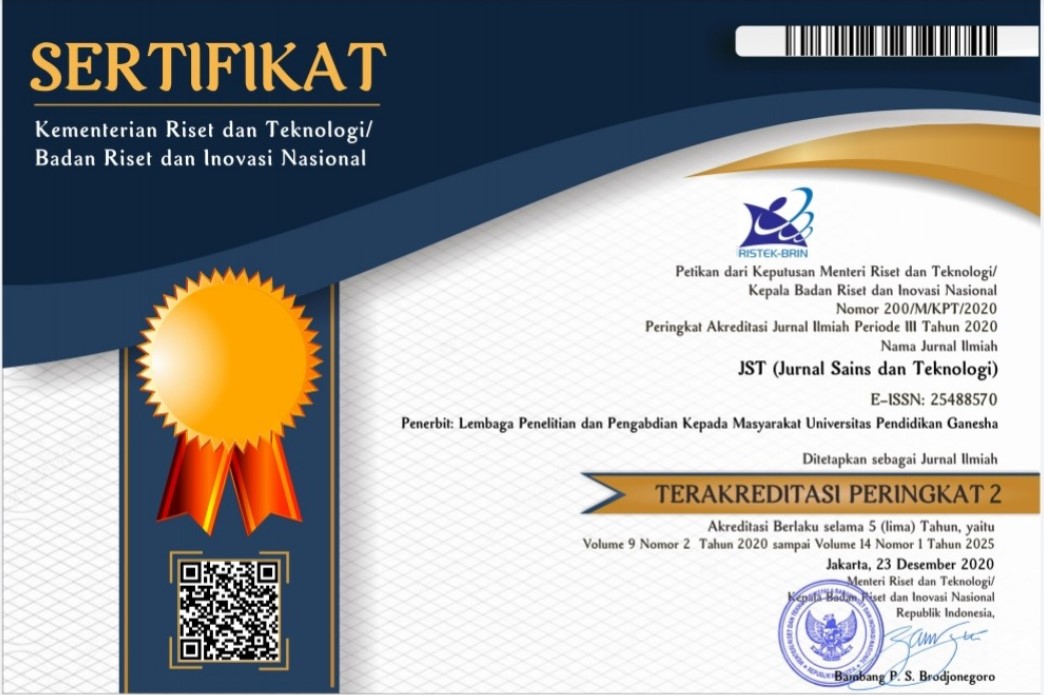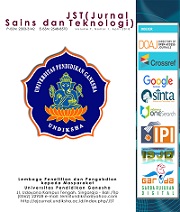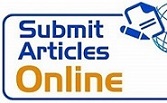Effect of NaCl Activator Concentration on Iodine Adsorption of PET- based Activated Carbon
DOI:
https://doi.org/10.23887/jstundiksha.v13i2.81448Kata Kunci:
Activated Carbon, Plastic PET, NaCl, IodineAbstrak
This study examines the use of NaCl as an activator in the production of activated carbon from Polyethylene terephthalate (PET) waste to overcome environmental problems due to the accumulation of plastic waste that is difficult to decompose. This study aims to examine the effect of NaCl concentration on the iodine adsorption capacity of activated carbon. This type of research is experimental research. The samples used were 15 samples of activated carbon. Data collection methods through laboratory experiments. Data analysis was performed by simple linear regression analysis. The results of the analysis showed that variations in NaCl concentration had a significant effect on iodine adsorption capacity, with an R² value of 0.868 indicating 86.8% of variations in adsorption capacity could be explained by NaCl concentration. A concentration of 1M was considered optimal in balancing effectiveness, production cost, and environmental impact, although higher concentrations resulted in better adsorption capacity. This study concludes that the utilization of PET waste for activated carbon production provides a sustainable solution to plastic pollution, reduces waste while producing high-value products for industrial applications, and contributes to the development of more environmentally friendly and economical activated carbon production methods.
Referensi
Ahangar, F. A., Rashid, U., Ahmad, J., Tsubota, T., & Alsalme, A. (2021). Conversion of waste polyethylene terephthalate (Pet) polymer into activated carbon and its feasibility to produce green fuel. Polymers, 13(22). https://doi.org/10.3390/polym13223952. DOI: https://doi.org/10.3390/polym13223952
Aulia, A., Azizah, R., Sulistyorini, L., & Rizaldi, M. A. (2023). Literature Review: Dampak Mikroplastik Terhadap Lingkungan Pesisir, Biota Laut dan Potensi Risiko Kesehatan. Jurnal Kesehatan Lingkungan Indonesia, 22(3), 328–341. https://doi.org/10.14710/jkli.22.3.328-341. DOI: https://doi.org/10.14710/jkli.22.3.328-341
Babaremu, K. O., Okoya, S. A., Hughes, E., Tijani, B., Teidi, D., Akpan, A., Igwe, J., Karera, S., Oyinlola, M., & Akinlabi, E. T. (2022). Sustainable plastic waste management in a circular economy. Heliyon, 8(7), 9984. https://doi.org/10.1016/j.heliyon.2022.e09984. DOI: https://doi.org/10.1016/j.heliyon.2022.e09984
Cahyono, M. S., Haryono, S., & Mandala, W. W. (2021). Proses Pirolisis Untuk Mengkonversi Limbah Plastik Menjadi Bahan Bakar Minyak Menggunakan Penyaringan Adsorban (Arang dan Zeolit. Jurnal Offshore: Oil, Production Facilities and Renewable Energy, 5(2), 74. https://doi.org/10.30588/jo.v5i2.993. DOI: https://doi.org/10.30588/jo.v5i2.993
Devi, M., & Rawat, S. (2021). A comprehensive review of the pyrolysis process : from carbon nanomaterial synthesis to waste treatment. Oxford Academi, 1(1), 30. https://doi.org/10.1093/oxfmat/itab014 DOI: https://doi.org/10.1093/oxfmat/itab014
Dhahak, A., Hild, G., Rouaud, M., Mauviel, G., & Burkle-Vitzthum, V. (2019). Slow pyrolysis of polyethylene terephthalate: Online monitoring of gas production and quantitative analysis of waxy products. Journal of Analytical and Applied Pyrolysis, 142(1). https://doi.org/https://doi.org/10.1016/j.jaap.2019.104664. DOI: https://doi.org/10.1016/j.jaap.2019.104664
Dzigbor, A., & Chimphango, A. (2019). Production and optimization of NaCl-activated carbon from mango seed using response surface methodology. Biomass Conversion and Biorefinery, 1(1), 16–18. https://doi.org/10.1007/s13399-018-0361-3. DOI: https://doi.org/10.1007/s13399-018-0361-3
Falkenberg, L. J., Bellerby, R. G. J., Connell, S. D., Fleming, L. E., Maycock, B., Russell, B. D., Sullivan, F. J., & Dupont, S. (2020). Ocean acidification and human health. International Journal of Environmental Research and Public Health, 17(12), 1–20. https://doi.org/10.3390/ijerph17124563. DOI: https://doi.org/10.3390/ijerph17124563
Firmansyah, Y W, Fuadi, M. F. (2021). Keberadaan Plastik di Lingkungan, Bahaya terhadap Kesehatan Manusia, dan Upaya Mitigasi: Studi Literatur. Jurnal Serambi Engineering, 6(4), 2279–2285. https://doi.org/https://doi.org/10.32672/jse.v6i4.3471. DOI: https://doi.org/10.32672/jse.v6i4.3471
Ganjoo, R., Sharma, S., & Kumar, A. (2023). Activated Carbon : Fundamentals , Classification ,. In Activated Carbon: Progress and Applications. In Activated Carbon: Progress and Applications. https://doi.org/10.1039/BK9781839169861-00001. DOI: https://doi.org/10.1039/BK9781839169861-00001
Gunawan, S., Hasan, H., & Lubis, R. D. W. (2020). Pemanfaatan Adsorben dari Tongkol Jagung sebagai Karbon Aktif untuk Mengurangi Emisi Gas Buang Kendaraan Bermotor. Jurnal Rekayasa Material, Manufaktur Dan Energi, 3(1), 38–47. https://doi.org/10.30596/rmme.v3i1.4527. DOI: https://doi.org/10.30596/rmme.v3i1.4527
He, X., Chen, X., Wang, X., & Jiang, L. (2023). Optimization of activated carbon production from corn cob using response surface methodology. Frontiers in Environmental Science, 11(January), 1–11. https://doi.org/10.3389/fenvs.2023.1105408. DOI: https://doi.org/10.3389/fenvs.2023.1105408
Heidarinejad, Z., Dehghani, M. H., Heidari, M., Javedan, G., Ali, I., & Sillanpää, M. (2020). Methods for preparation and activation of activated carbon: a review. Environmental Chemistry Letters, 18(2), 393–415. https://doi.org/10.1007/s10311-019-00955-0. DOI: https://doi.org/10.1007/s10311-019-00955-0
Ilyas, M., Ahmad, W., & Khan, H. (2021). Utilization of activated carbon derived from waste plastic for decontamination of polycyclic aromatic hydrocarbons laden wastewater. Water Science and Technology, 84(3), 609–631. https://doi.org/10.2166/wst.2021.252. DOI: https://doi.org/10.2166/wst.2021.252
Karolinoerita, V., & Annisa, W. (2020). Salinisasi Lahan dan Permasalahannya di Indonesia. Jurnal Sumberdaya Lahan, 14(2), 91. https://doi.org/10.21082/jsdl.v14n2.2020.91-99. DOI: https://doi.org/10.21082/jsdl.v14n2.2020.91-99
Maerani, I. A., Maharani, R. K., Rohman, M. N., Eriyani, D., Nabila, F., & Wahyudha, A. (2023). Metode Edukasi dan Pelatihan Pengelolaan Sampah Plastik untuk Kerajinan di SDN Bedono 1 Sayung, Demak. Indonesian Journal of Community Services, 5(1), 114. https://doi.org/10.30659/ijocs.5.1.114-. DOI: https://doi.org/10.30659/ijocs.5.1.114-122
Manik, Y., Paramerta, N. M. A. P., Nadhifah, D. F., Cosaken, E. C., Saefurrahman, F., Stephanie, I., & Widi, S. S. (2023). Providing eco-literacy outreach to generation alpha using game-based Plastic recycling activity: Case study with foster children of an orphanage. Jurnal Masyarakat Mandiri, 7(5). https://doi.org/10.31764/jmm.v7i5.17325. DOI: https://doi.org/10.31764/jmm.v7i5.17325
Novia, T. (2021). Pengolahan Limbah Sampah Plastik Polytthylene. GRAVITASI Jurnal Pendidikan Fisika Dan Sains, 4(4), 33–41. https://doi.org/10.1016/j.clema.2024.100220. DOI: https://doi.org/10.33059/gravitasi.jpfs.v4i01.3481
Oko, S., Mustafa, M., Kurniawan, A., & Norfitria, L. (2021). Pembuatan Karbon Aktif dari Limbah Plastik PET (Polyethylene terephthalate) Menggunakan Aktivator KOH. METANA, 17(2), 61–68. https://doi.org/10.14710/metana.v17i2.40204. DOI: https://doi.org/10.14710/metana.v17i2.40204
Pilapitiya, P. G. N. T., & Ratnayake, A. S. (2024). The world of plastic waste: A review. Cleaner Materials, 11(August 2023), 100220. https://doi.org/10.1016/j.clema.2024.100220. DOI: https://doi.org/10.1016/j.clema.2024.100220
Radika, R., & Astuti, A. (2020). Pengaruh Variasi Konsentrasi NaCl sebagai Aktivator Karbon Aktif Kulit Singkong untuk Menurunkan Konsentrasi Logam Berat Air Sungai Batang Ombilin. Jurnal Fisika Unand, 9(2), 163–168. https://doi.org/10.25077/jfu.9.2.163-168.2020. DOI: https://doi.org/10.25077/jfu.9.2.163-168.2020
Schwarz, A. E., Ligthart, T. N., Godoi Bizarro, D., Wild, P., Vreugdenhil, B., & Harmelen, T. (2021). Plastic recycling in a circular economy; determining environmental performance through an LCA matrix model approach. Waste Management, 121(1), 331–342. https://doi.org/10.1016/j.wasman.2020.12.020. DOI: https://doi.org/10.1016/j.wasman.2020.12.020
Sharifian, S., & Asasian-Kolur, N. (2022). Polyethylene terephthalate (PET) waste to carbon materials: Theory, methods and applications. Journal of Analytical and Applied Pyrolysis, 163(1), 105496. https://doi.org/10.1016/j.jaap.2022.105496. DOI: https://doi.org/10.1016/j.jaap.2022.105496
Smeaton, C. (2021). Augmentation of global marine sedimentary carbon storage in the age of plastic. Limnology And Oceanography Letters, 6(3). https://doi.org/https://doi.org/10.1002/lol2.10187. DOI: https://doi.org/10.1002/lol2.10187
Subekti, R. (2023). A Circular Economy-Based Plastic Waste Management Policy in Indonesia (Compared to China and EU. Yustisia, 12(2), 168–184. https://doi.org/10.20961/yustisia.v12i2.72177. DOI: https://doi.org/10.20961/yustisia.v12i2.72177
Tarmidzi, F. M., Anindita, M., Putri, S., Andriani, A. N., & Alviany, R. (2021). Pengaruh Aktivator Asam Sulfat dan Natrium Klorida pada Karbon Aktif Batang Semu Pisang untuk Adsorpsi Fe. Jurnal Rekayasa Bahan Alam Dan Energi Berkelanjutan, 5(1), 17–21. https://doi.org/10.21776/ub.rbaet.2021.005.01.03. DOI: https://doi.org/10.21776/ub.rbaet.2021.005.01.03
Ukanwa, K. S., Patchigolla, K., Sakrabani, R., Anthony, E., & Mandavgane, S. (2019). A Review of Chemicals to Produce Activated Carbon from Agricultural Waste Biomass. MDPI Sustainability, 11(1), 1–35. https://doi.org/10.3390/su11226204. DOI: https://doi.org/10.3390/su11226204
Utomo, L. W., & Susi Arfiana, D. (2023). Pemanfaatan Limbah Plastik Daur Ulang dari Polietilen Tereftalat (PET) Sebagai Bahan Tambahan dalam Pembuatan Nanokomposit, Semen Mortar, dan Aspal. Jurnal Teknologi Lingkungan Lahan Basah, 11(1), 164–179. https://doi.org/10.26418/jtllb.v11i1.60812. DOI: https://doi.org/10.26418/jtllb.v11i1.60812
Wilson, T. J. B., Cooley, S. R., Tai, T. C., Cheung, W. W. L., & Tyedmers, P. H. (2020). Potential socioeconomic impacts from ocean acidification and climate change effects on Atlantic Canadian fisheries. PLoS ONE, 15(1), 1–29. https://doi.org/10.1371/journal.pone.0226544. DOI: https://doi.org/10.1371/journal.pone.0226544
Yaqoob, L., Noor, T., & Iqbal, N. (2022). Conversion of Plastic Waste to Carbon-Based Compounds and Application in Energy Storage Devices. ACS Omega, 7(16), 13403–13435. https://doi.org/10.1021/acsomega.1c07291. DOI: https://doi.org/10.1021/acsomega.1c07291
Zepka, L. Q. (2019). Renewable Resources and Biorefineries. In Renewable Resources and Biorefineries. https://doi.org/10.5772/intechopen.75236. DOI: https://doi.org/10.5772/intechopen.75236
Zhao, X., Korey, M., Li, K., Copenhaver, K., Tekinalp, H., Celik, S., Kalaitzidou, K., Ruan, R., Ragauskas, A. J., & Ozcan, S. (2022). Plastic waste upcycling toward a circular economy. Chemical Engineering Journal, 428(1), 131928. https://doi.org/10.1016/j.cej.2021.131928. DOI: https://doi.org/10.1016/j.cej.2021.131928
Unduhan
Diterbitkan
Cara Mengutip
Terbitan
Bagian
Lisensi
Hak Cipta (c) 2024 Fadilatur Rahmi Agus, Yosef Barita Sar Manik

Artikel ini berlisensiCreative Commons Attribution-ShareAlike 4.0 International License.
Authors who publish with the Jurnal Sains dan Teknologi (JST) agree to the following terms:
- Authors retain copyright and grant the journal the right of first publication with the work simultaneously licensed under a Creative Commons Attribution License (CC BY-SA 4.0) that allows others to share the work with an acknowledgment of the work's authorship and initial publication in this journal.
- Authors are able to enter into separate, additional contractual arrangements for the non-exclusive distribution of the journal's published version of the work (e.g., post it to an institutional repository or publish it in a book), with an acknowledgment of its initial publication in this journal.
- Authors are permitted and encouraged to post their work online (e.g., in institutional repositories or on their website) prior to and during the submission process, as it can lead to productive exchanges, as well as earlier and greater citation of published work. (See The Effect of Open Access)















